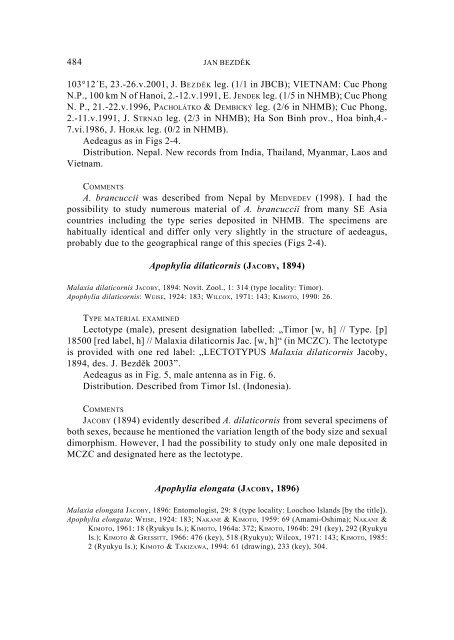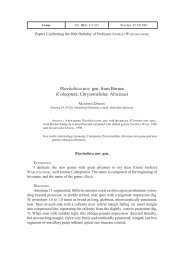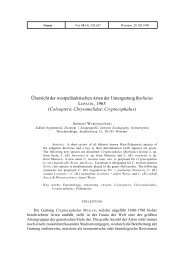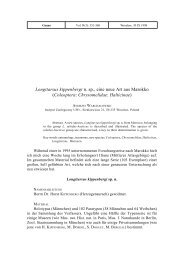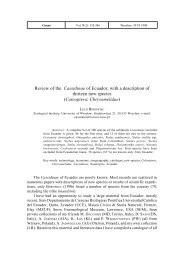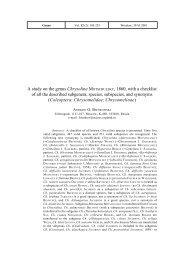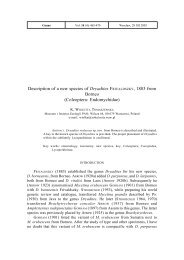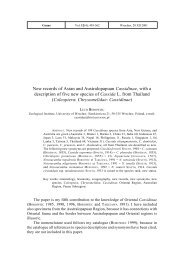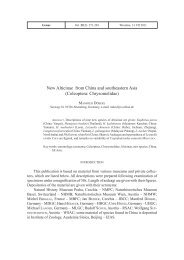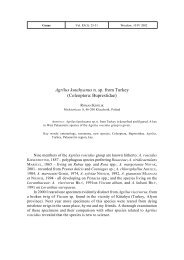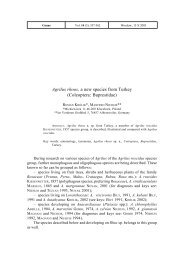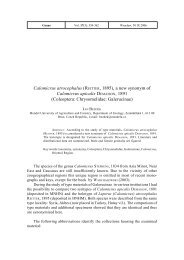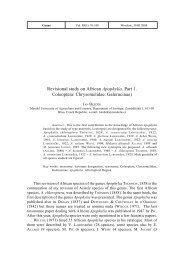Studies on asiatic Apophylia. Part 5: Revisional study of type ...
Studies on asiatic Apophylia. Part 5: Revisional study of type ...
Studies on asiatic Apophylia. Part 5: Revisional study of type ...
Create successful ePaper yourself
Turn your PDF publications into a flip-book with our unique Google optimized e-Paper software.
484 JAN BEZDÌK<br />
103°12´E, 23.-26.v.2001, J. BEZDÌK leg. (1/1 in JBCB); VIETNAM: Cuc Ph<strong>on</strong>g<br />
N.P., 100 km N <strong>of</strong> Hanoi, 2.-12.v.1991, E. JENDEK leg. (1/5 in NHMB); Cuc Ph<strong>on</strong>g<br />
N. P., 21.-22.v.1996, PACHOLÁTKO & DEMBICKÝ leg. (2/6 in NHMB); Cuc Ph<strong>on</strong>g,<br />
2.-11.v.1991, J. STRNAD leg. (2/3 in NHMB); Ha S<strong>on</strong> Binh prov., Hoa binh,4.-<br />
7.vi.1986, J. HORÁK leg. (0/2 in NHMB).<br />
Aedeagus as in Figs 2-4.<br />
Distributi<strong>on</strong>. Nepal. New records from India, Thailand, Myanmar, Laos and<br />
Vietnam.<br />
COMMENTS<br />
A. brancuccii was described from Nepal by MEDVEDEV (1998). I had the<br />
possibility to <strong>study</strong> numerous material <strong>of</strong> A. brancuccii from many SE Asia<br />
countries including the <strong>type</strong> series deposited in NHMB. The specimens are<br />
habitually identical and differ <strong>on</strong>ly very slightly in the structure <strong>of</strong> aedeagus,<br />
probably due to the geographical range <strong>of</strong> this species (Figs 2-4).<br />
<strong>Apophylia</strong> dilaticornis (JACOBY, 1894)<br />
Malaxia dilaticornis JACOBY, 1894: Novit. Zool., 1: 314 (<strong>type</strong> locality: Timor).<br />
<strong>Apophylia</strong> dilaticornis: WEISE, 1924: 183; WILCOX, 1971: 143; KIMOTO, 1990: 26.<br />
TYPE MATERIAL EXAMINED<br />
Lecto<strong>type</strong> (male), present designati<strong>on</strong> labelled: „Timor [w, h] // Type. [p]<br />
18500 [red label, h] // Malaxia dilaticornis Jac. [w, h]“ (in MCZC). The lecto<strong>type</strong><br />
is provided with <strong>on</strong>e red label: „LECTOTYPUS Malaxia dilaticornis Jacoby,<br />
1894, des. J. Bezdìk 2003”.<br />
Aedeagus as in Fig. 5, male antenna as in Fig. 6.<br />
Distributi<strong>on</strong>. Described from Timor Isl. (Ind<strong>on</strong>esia).<br />
COMMENTS<br />
JACOBY (1894) evidently described A. dilaticornis from several specimens <strong>of</strong><br />
both sexes, because he menti<strong>on</strong>ed the variati<strong>on</strong> length <strong>of</strong> the body size and sexual<br />
dimorphism. However, I had the possibility to <strong>study</strong> <strong>on</strong>ly <strong>on</strong>e male deposited in<br />
MCZC and designated here as the lecto<strong>type</strong>.<br />
<strong>Apophylia</strong> el<strong>on</strong>gata (JACOBY, 1896)<br />
Malaxia el<strong>on</strong>gata JACOBY, 1896: Entomologist, 29: 8 (<strong>type</strong> locality: Loochoo Islands [by the title]).<br />
<strong>Apophylia</strong> el<strong>on</strong>gata: WEISE, 1924: 183; NAKANE & KIMOTO, 1959: 69 (Amami-Oshima); NAKANE &<br />
KIMOTO, 1961: 18 (Ryukyu Is.); KIMOTO, 1964a: 372; KIMOTO, 1964b: 291 (key), 292 (Ryukyu<br />
Is.); KIMOTO & GRESSITT, 1966: 476 (key), 518 (Ryukyu); Wilcox, 1971: 143; KIMOTO, 1985:<br />
2 (Ryukyu Is.); KIMOTO & TAKIZAWA, 1994: 61 (drawing), 233 (key), 304.


